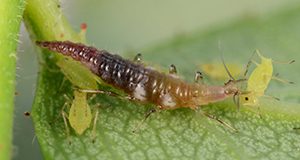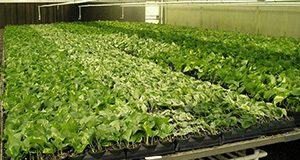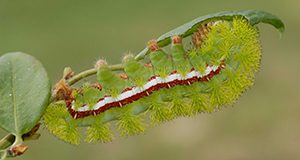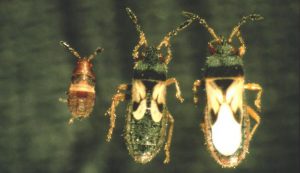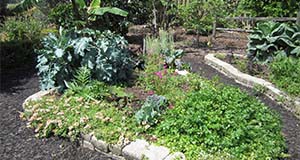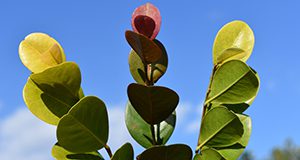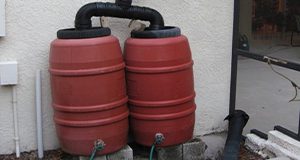Crown gall is a bacterial disease that causes large, tumor-like swellings (galls) that often occur at the crown of the plant. This 3-page document describes the symptoms and management of this disease on roses. Written by Kamil Duman, Susannah da Silva, Fanny Iriarte, Barron Riddle, Gary Knox, Matthew Orwat, Shawn Steed, E. Vanessa Compoverde, Jeffrey Jones, and Mathews Paret and published by the UF/IFAS Plant Pathology Department, November 2018.
http://edis.ifas.ufl.edu/pp343
Category: Lawn & Garden
Natural Products for Managing Landscape and Garden Pests in Florida
Pest control professionals and homeowners throughout Florida and the southeastern US are seeking effective options that are safer for people and the environment than some conventional synthetic pesticides. There is also rising interest in organic gardening, which relies on natural pesticides. This 13-page fact sheet describes natural products for use in residential landscapes and gardens. Written by Matthew A. Borden, Eileen A. Buss, Sydney G. Park Brown, and Adam G. Dale, and published by the UF/IFAS Department of Entomology and Nematology, revised September 2018.
http://edis.ifas.ufl.edu/in197
Key Program Outcomes for K-12 School Gardens Identified Through Expert Consensus
National trends indicate that school gardens are positioned to become fixtures in primary and secondary education. This 4-page document outlines key outcomes identified through expert consensus that can be used by Extension professionals to develop a logic model for the school garden program. Written by Susan Webb, John Diaz, and Catherine Campbell and published by the UF/IFAS Department of Agricultural Education and Communication, September 2018.
http://edis.ifas.ufl.edu/wc312
Managing Insecticide and Miticide Resistance in Florida Landscapes
Resistance to insecticide or miticide is a worry for landscape managers. Around the world, chinch bugs, leafminers, and other insect and mite pests have become resistant to dozens of insecticides, but with diligent insecticide resistance management, we can still maintain long-term effective chemical control. With few new modes of action coming onto the market, landscape managers need to be good stewards of existing products. Ultimately, resistance management means reducing exposure of pests to any one pesticide. Fortunately, there are many ways to prevent resistance and still control pests of ornamental plants and lawns, and this 6-page fact sheet written by Nicole Benda and Adam Dale and published by the UF/IFAS Entomology and Nematology Department explains how.
http://edis.ifas.ufl.edu/in714
Pothos (Epipremnum aureum) Diseases: Identification and Control in Commercial Greenhouse Production
Pothos is a tropical ornamental vine that has been grown commercially in the US for almost 100 years and is used for a variety of aesthetic purposes. This 5-page publication addresses identification and treatment of common diseases encountered during greenhouse production of pothos. Written by David J. Norman and G. Shad Ali and published by the UF/IFAS Plant Pathology Department, July 2018.
http://edis.ifas.ufl.edu/pp340
Using Video Messages to Promote Residential Adoption of Fertilizer Best Practices
Residents may be inclined to over-fertilize their lawns due to pressure to maintain a neighborhood aesthetic. However, this activity can affect water quality. This 3-page document describes a study that was conducted in order to determine if video messages about fertilizer best management practices influenced perceptions of fertilizer use among residents. Written by Amanda D. Ali, Laura A. Sanagorski Warner, Peyton Beattie, Alexa J. Lamm, and Joy N. Rumble and published by the UF/IFAS Department of Agricultural Education and Communication, July 2018.
http://edis.ifas.ufl.edu/wc309
Biology and Management of the Bermudagrass Mite, Eriophyes cynodoniensis
The bermudagrass mite, Eriophyes cynodoniensis (Sayed) (Arthropoda: Arachnida: Eriophyidae), also known as the couch grass mite, can be a serious pest of bermudagrass in multiple high-maintenance turf systems such as sod production, athletic fields, and golf courses. Mites cause leaf and bud galls, which can lead to severe aesthetic damage and plant decline or death in high-maintenance areas with low tolerance for plant damage. In this 7-page fact sheet written by Pablo Agustin Boeri, Nicole D. Benda, J. Bryan Unruh, and Adam Dale and published by the UF/IFAs Entomology and Nematology Department, review the biology, identification, and management of the bermudagrass mite, and get specific management recommendations based on evidence from UF/IFAS research.
https://edis.ifas.ufl.edu/in1217
Key Plant, Key Pests: Chinese Elm (Ulmus parvifolia)
This 5-page document is one in the Key Plant, Key Pests series. It helps identify common pests found on the Chinese elm (Ulmus parvifolia). Written by Juanita Popenoe, Caroline R. Warwick, and Richard Beeson Jr. and published by the UF/IFAS Environmental Horticulture Department, July 2018.
https://edis.ifas.ufl.edu/ep559
Stinging and Venomous Caterpillars of the Southeast
Wasp and bee stings are familiar to most people, but some might be surprised to learn that several caterpillars can also sting. Unlike wasps and bees with stingers, these caterpillars have barbed hairs that break off the caterpillar when it brushes against something. The hairs embed in skin and cause sudden or gradually building pain. The severity of a caterpillar sting varies based on the person and number of spines in the skin. Many stinging caterpillars also release a toxin on contact, which may cause health problems for some people. This 4-page fact sheet written by Rebecca Perry and Adam Dale and published by the UF/IFAS Department of Entomology and Nematology describes several stinging caterpillars commonly found throughout the southeastern United States.
https://edis.ifas.ufl.edu/in014
Managing Southern Chinch Bug in Warm Season Turfgrasses
Southern chinch bug, Blissus insularis Barber, is the most damaging insect pest of St. Augustinegrass in the United States. St. Augustinegrass is the most common turfgrass used in Florida. The ubiquity of this single turfgrass species makes southern chinch bug an economically important pest in the state. In fact, chinch bugs cost Florida homeowners and professionals millions of dollars every year. This 7-page fact sheet written by Eileen A. Buss, Brianna M. Whitman, and Adam G. Dale and published by the UF/IFAS Department of Entomology and Nematology describes the biology of the pest and the damage it causes and lists ways to scout and monitor for chinch bugs and some strategies for control of the pest.
http://edis.ifas.ufl.edu/lh036
Cat’s-Claw Vine, Dolichandra unguis-cati : A Showy but Invasive Plant in Florida
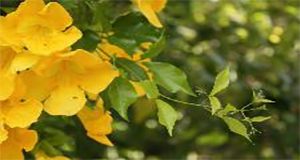
Cat’s-claw vine is a neotropical, climbing perennial that produces large and showy yellow flowers in the springtime. Unfortunately, the aggressive nature of the vine has made it a major weed in China, Australia, South Africa, and parts of the southeastern United States. This 6-page fact sheet written by Niels Proctor and Jason Smith and published by the UF/IFAS School of Forest Resources and Conservation provides guidance on identification and control of this invasive vine and suggests some similar native vines to use instead.
http://edis.ifas.ufl.edu/fr391
Florida-Friendly Landscaping Guidelines for Community Associations: Considerations for Selecting a Landscape Contractor and Writing an Effective Landscaping Contract
Florida-Friendly Landscaping protects Florida’s unique natural resources by conserving water, reducing waste and pollution, creating wildlife habitat, and preventing erosion. This 12-page document will help the reader with selecting and writing a landscape contract that follows Florida-Friendly Landscaping principles. Written by Adam Dale, Claire Lewis, Esen Momol, Don Rainey, John Bossart, C. J. Bain, Jen Marvin, Lynn Barber, Norman Leppla, Gary Knox, and Thomas T. Ankerson and published by the UF/IFAS Environmental Horticulture Department, June 2018.
http://edis.ifas.ufl.edu/ep347
Using Environmentally Themed Videos to Help Extension Promote Good Landscape Management Behaviors
Water quality and quantity are major issues in the state of Florida, and water resources can be affected by the way residents choose to fertilize and irrigate their lawns and landscapes. This 4-page document discusses the use of videos to promote good landscape management behaviors. Written by Laura A. Sanagorski Warner, Alexa J. Lamm, and Joy N. Rumble and published by the Department of Agricultural Education and Communication, May 2018.
http://edis.ifas.ufl.edu/wc302
Stakeholder-Identified Barriers, Challenges, and Obstacles in Community Gardens
Florida Extension agents play a vital role in assisting community members to start and sustain community gardens through site visits, workshops, and educational events. This 3-page document discusses the results of a Delphi study conducted in order to create a picture of the barriers, challenges, and obstacles to starting and sustaining community gardens in Florida. Written by Susan Webb and John Diaz and published by the UF/IFAS Department of Agricultural Education and Communication, March 2018.
http://edis.ifas.ufl.edu/wc301
Cocoplum (Chrysobalanus icaco L.) Identification and Uses
Cocoplum is one of two native Florida plants in the Chrysobalanaceae family, and is found in a variety of habitats. This 9-page document discusses the identification and uses of cocoplum. Written by Stephen H. Brown and Marc S. Frank and published by the UF/IFAS Environmental Horticulture Department, March 2018.
http://edis.ifas.ufl.edu/ep553
Calcium for Florida Turfgrasses
Calcium is the dominant cation in all soils of agronomic importance. This 3-page document will explain the function of Calcium in turfgrasses, describe situations where applications would or would not be of value in turfgrass management, and identify calcium sources. Written by T. W. Shaddox and published by the UF/IFAS Environmental Horticulture Department, March 2018.
http://edis.ifas.ufl.edu/ep554
Magnesium for Florida Turfgrasses
Soluble magnesium (Mg) is often applied to turfgrasses in both granular and foliar forms, and is therefore essential to understanding the function of Mg in the plant, the dynamics of Mg in the soil, and the forms of Mg fertilizers. This 3-page document discusses the function and forms of magnesium in turfgrasses. Written by T. W. Shaddox and published by the UF/IFAS Environmental Horticulture Department, March 2018.
http://edis.ifas.ufl.edu/ep555
Rain Barrel Owners: Meeting the Programming Needs of This Unique Extension Audience
Rain barrels make it easy for households to practice water conservation. Extension programs for rain barrel construction, decoration, and giveaways can raise awareness for (and encourage use of) this technology. This 9-page document will provide insight into the behavior and attitudes of rain barrel owners so that Extension professionals may gain a better understanding of this unique audience. Written by Emily Ott, Paul Monaghan, Wendy Wilber, Lynn Barber, and Karissa Raymond and published by the UF/IFAS Department of Agricultural Education and Communication, March 2018.
http://edis.ifas.ufl.edu/wc297
Abelia x grandiflora: Glossy Abelia
Glossy abelia is a sprawling shrub that works well as a background or massing plant. This 3-page fact sheet describes its characteristics and management. Written by Edward F. Gilman, Ryan W. Klein, and Gail Hansen and published by the UF/IFAS Environmental Horticulture Department, February 2018.
http://edis.ifas.ufl.edu/fp001
Stakeholder-Identified Community Garden Program Outcomes
Extension clientele often contact agents for expertise on starting or maintaining a community garden; however, agents’ ability to collect meaningful data from these activities can be a challenge. This 3-page publication discusses a statewide study that was conducted by the author to identify community garden outcomes. Written by Susan Webb and John Diaz and published by the UF/IFAS Department of Agricultural Education and Communication, January 2018.
http://edis.ifas.ufl.edu/wc295

